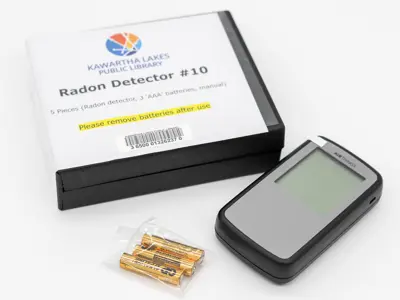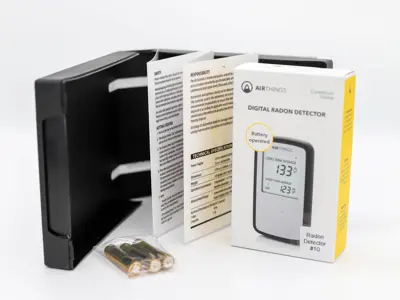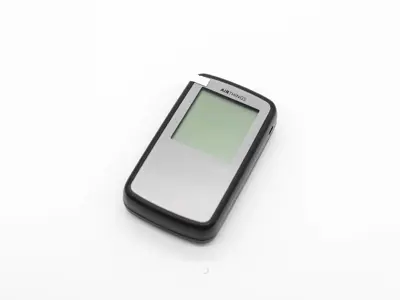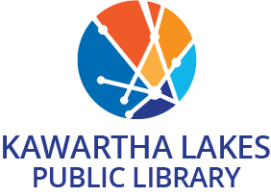- Dimensions: 4.7 x 2.7 x 1.0 inches / 120mm × 69mm × 25.5mm
- Weight: 5.2 ounces / 130g (with batteries)
- Operation environment:
- Temperature: 39°F to 104°F / 4°C to 40°C
- Relative Humidity: < 85%
- Measurement range:
- 0 – 500 pCi/L
- 0 - 9999 Bq/m³
Radon Detectors
Radon is an invisible, odourless, and colourless gas that naturally forms when uranium breaks down in soil and rock. While it’s not dangerous outdoors due to dilution, radon can build up to hazardous levels inside homes. In Canada, radon is the leading cause of lung cancer among non-smokers, and the risk is even greater for smokers. Testing for radon in enclosed spaces like homes is the only way to determine if your family is at risk. Kawartha Lakes Public Library now radon detectors for loan, allowing you to check your home’s radon levels.

Borrowing a Radon Detector
How to Borrow
- Radon detectors have a six (6) week loan period (not renewable) and should be placed in the home for at least 30 continuous days to get a proper reading.
- Search the library catalogue for Radon Detector.
- Radon Detectors can be placed on hold and made available for pick up from one of our local library branches closest to you.
- Radon detectors are available to borrow from October 1 to March 31. This is the best time to test because radon levels are higher when homes are less ventilated during colder months
How to Return
- Radon detectors can be returned to any Kawartha Lakes library branch during opening hours.
- Any damaged or broken radon detectors have a replacement cost of $126.00


Protect Your Home and Your Health
Don’t wait to find out if radon is putting you at risk. Borrow a free radon detector from our Library of THINGS and test your home today.
What is Radon?
Radon is a radioactive gas formed by the natural breakdown of uranium in the earth’s crust. Although it is undetectable by sight, smell, or taste, radon can pose a serious health risk when it accumulates indoors. Radon gas itself breaks down into tiny radioactive particles, which, when inhaled, can damage lung tissue and increase the risk of lung cancer. It is the primary cause of lung cancer for non-smokers in Canada and further heightens the risk for smokers. Understanding radon and testing your home are critical steps to protect your health.
How Does Radon Get into Your Home?
Radon typically enters your home through any cracks or openings where the house meets the ground. The lower air pressure inside homes compared to the soil around the foundation creates a vacuum effect, drawing radon inside through cracks in floors and walls, construction joints, and gaps around pipes and drains. Basements, crawl spaces, and lower floors are particularly susceptible. Even homes next door to each other can have vastly different radon levels, which is why every home should be tested individually.
The only way to know if the levels in your home are dangerous is to test. Since uranium is common in Canadian soil, radon concentrations can vary significantly across the country and even from one home to another. Testing your home is essential because prolonged exposure to high levels of radon can be dangerous. The Government of Canada recommends action if radon levels exceed 200 Bq/m³. Start with a quick test using a digital radon monitor, which can be borrowed from one of our Kawartha Lakes Public Library branches.
Resources or More information:
Lakelands Public Health | Radon - https://www.lakelandsph.ca/health-topics/home-safety/radon/
Government of Canada | Radon - https://www.canada.ca/en/health-canada/services/health-risks-safety/radiation/radon.html
Take Action on Radon - https://takeactiononradon.ca/
Take Action on Radon | Find a Radon Mitigation Professional - https://takeactiononradon.ca/protect/find-a-radon-mitigation-professional/
Kawartha Lakes Public Library Catalog | Radon Detector - https://kawarthalibrary.bibliocommons.com/v2/record/S192C4742516
Lungs Matter: Radon Mitigation Support | Canadian Lung Association
Knowvember – Get in the know about radon. This site has lots of information and an interactive game.
Contact Us
Kawartha Lakes Public Library
P.O. Box 9000, 190 Kent Street West
Lindsay, Ontario, K9V 2Y6
Phone: 705-324-9411 ext 1291
Email
